


Introduction to Moss Morphology
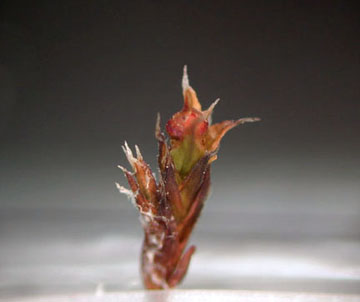 |
||
| Schistidium apocarpum |
MORPHOLOGY AND DEVELOPMENT OF THE MOSSES
Similar to plants, the moss lifecycle is completed in two distinct stages - the gametophyte and the sporophyte. The term that describes this type of life history is called alternation of heteromorphic generations. In vascular plants the dominant stage of this lifecycle is the diploid generation. In mosses, the dominant stage is the haploid generation (the gametophyte). This means that the green, leafy gametophytic tissue is haploid (has only one set of chromosomes).
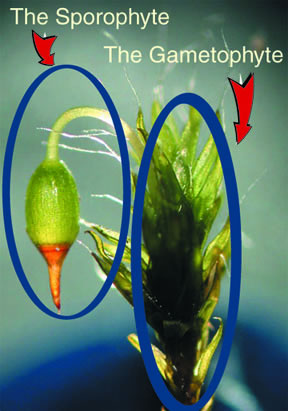 |
|
Grimmia
pulvinata
|
THE GAMETOPHYTE
The gametophyte refers to all organs and tissues that are a part of the haploid generation. There are two different developmental stages of the gametophyte: the protonema, and the gametophore. The protonema is the first part of the moss that develops from the germinating spore. Its filamentous form is remarkably similar to green algae. This photosynthetic colonizer lies flat against its substrate, making it seem as if the rock or tree it grows on is painted green. The protonema will eventually produce leafy shoots called gametophores.
The gametophores are the most conspicuous part of the moss. Although these shoots seem to vary from moss to moss, there are many morphological characteristics that are common to most of the mosses. For instance, most mosses have spirally arranged leaves that are one cell layer thick (unistratose).
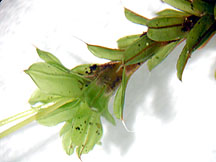 |
| Plagiomnium insigne - this picture shows the spirally arrange leaves common to most mosses |
Generally most mosses have multicellular stems and rhizoids associated with these stems. Of course there are always exceptions to these norms, but they are rare.
Rhizoids in the mosses are multicellular, but uniseriate (exception: Andreaeidae mosses have biseriate rhizoids). This means that more than one cell is needed to make a rhizoid and that these cells are aligned end to end, forming a filament. Rhizoids usually arise from the cortical cells of the stem, but can occasionally grow out of leaves. In mosses, the rhizoids have oblique crosswalls and are non-photosynthetic. Unlike the roots in plants, rhizoids do not absorb water or nutrients from the substrate; instead, their main function is to attach the plant to its substrate. It is thought rhizoids also play a role in water retention and conduction by capillary action.
Stems in mosses are multicellular and can show a surprising amount of tissue differentiation depending on the species of moss. Typically, most mosses have cortical cells (also called parenchyma cells) that compose much of the stem, and thick walled cells called stereids for structural support. Some mosses have internal conducting strands that guide water and even metabolites through the stem. In general the cells that conduct water are called hydroids and cells that conduct metabolites are called leptoids. Most hair cap mosses (Polytrichidae) have highly differentiated stem cells. Stems can also have appendages other than leaves. For example, paraphyllia, which are tiny photosynthetic filaments, are found on the stems of a few mosses, such as Hylocomium splendens. Some species of Sphagnum have retort cells (elongate cells with a pore terminating the upper end) associated with the surface of the stem
The leaves are very interesting organs because they can show a great degree of specialization between different species of moss. Generally, most leaves are photosynthetic and are composed of a single layer of elongate cells. Unlike the leaves in leafy liverworts, mosses have leaves that are spirally arranged and are never lobed (although this can be debated when considering the leaves of Takakia). Many moss leaves also have a costa, which is a midrib of specialized cells that runs lengthwise through the leaf.
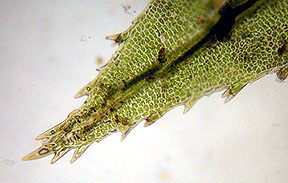 |
| Atrichum leaf showing specialized cells |
Like the stem, the cells of the costa can show a great deal of differentiation. These specialized cells include: stereids, guide cells, hydroids and leptoids. Guide cells are noticeable large cells that are continuos with the cells that make up the rest of the leaf blade (the lamina). Leaves can have many modifications that are specific to family, or to a species, and are very useful when trying to identify a moss. Here is a list of some of these novel characteristics:
- Undulations: refers
to waves that run perpendicular to the length of the leaf
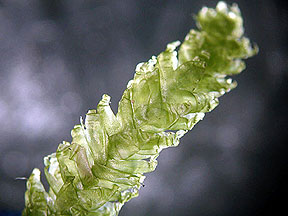
Snake moss showing undulating leaves - Pleats: refers to wrinkles that run along the length of the leaf
- toothed margins: are sharp extensions of the leaf margins - see Atrichum picture above
- lamellae: photosynthetic cells that form filaments or plates along the lamina or costa of the leaf. They are found in the Polytrichidae
- incurved margins: margins that are curved upwards and towards the center of leaf
- recurved margins: margins that are curved downwards and towards the center of the leaf
- hair point / awn:
refers to the extension of the costa beyond the tip of blade, producing
a hair or bristle.
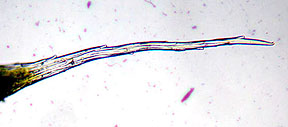
Grimmia pulvinata - leaf awn - Papillae: refers to bulges of cell wall thickenings of certain cells
- Pits: refers to a perforation or hole in the cell wall of certain cells.
- Hyaline cells:
Large, non-photosynthetic, porous cells found in Sphagnum leaves.
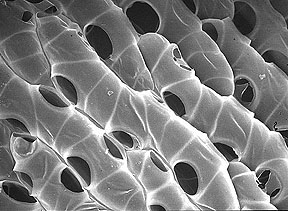
SEM of Sphagnum rubellum hyaline cells
- Alar: refers to the basal corner of a leaf where cells are most often larger than the other cells of the leaf.
The archegonia and the antheridia are the female and male reproductive organs in the mosses. The male will produce coiled biflagellated sperm cells that will swim towards the egg that lies within the archegonia. Because water is needed for the sperm cells to reach the egg, this is one of the reasons why moss seem to be more prevalent in wet areas. Once fertilized, the zygote will mature to produce the sporophyte.
THE SPOROPHYTE
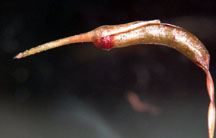 |
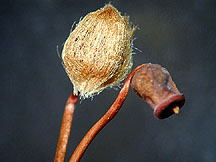 |
| Atrichum undulatum sporophyte | Polytrichum piliferum sporophyte |
The sporophyte refers to the diploid generation of the moss. It remains attached to the gametophyte (the haploid mother), and is in fact, parasitic upon it. The sporophyte relies on the gametophyte to provide it with food and water, which are passed through transfer cells that lie in the placental layer between the gametophyte and the sporophyte. Transfer cells have convoluted cell walls that increase surface area for nutrient exchange. In most mosses the sporophyte will have these anatomical features: a foot, seta, a sporangium with a columella, spores, an operculum, peristome teeth, and a calyptra.
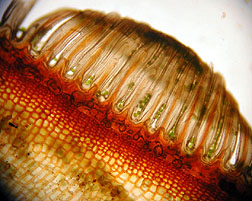 |
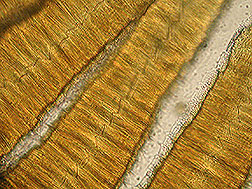 |
| Atrichum undulatum teeth - sporangium cross section | Peristome teeth of a bryidae member - microscopic view |
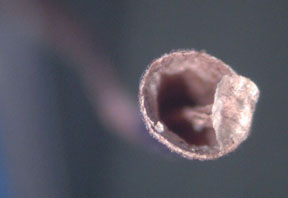 |
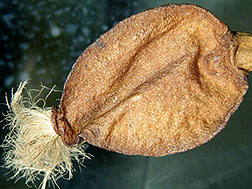 |
| Bartramiopsis lescurii - tooth-less sporangium | Dawsonia superba sporophyte - note myriad bristle-like teeth |
Most moss sporophytes have a seta except for those in the Andreaeidae and the Sphagnidae, which have pseudopodia instead. A seta is a long stem-like organ that connects the sporangium to the gametophyte. In mosses the seta elongates before the sporangium matures, which is opposite to the liverworts. The seta is usually composed of parenchyma cells, stereids, and many times a well developed conducting strand. Many species of moss have both hydroids and leptoids in the seta. The base of the seta is called the foot.
The sporangium is the main body of the sporophyte and is the organ in which the spores are produced. As previously mentioned, most mosses will have a sporangium with these anatomical features:
A sporogenous layer, a columella, peristome teeth, and an operculum.
Also, most mosses (except Sphagnum) have a calyptra to protect the developing sporangium. This calyptra is technically gametophytic, since it is composed of haploid tissue that was once a part of the archegonium. The calyptra can take many different forms depending on the species of moss. It can be bald (most mosses) or hairy (mosses in the Polytrichidae). This appendage will eventually be shed prior to spore dispersal.
 |
| Polytrichum piliferum - showing its hairy calyptra |


